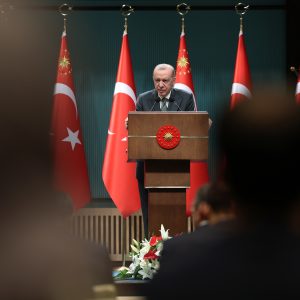UN climate conference head warns ‘time is running out’ to meet climate targets
ANKARA (AA) – Despite some positive developments towards reducing carbon emissions, global efforts need to be accelerated, as progress has been too limited and slow, according to the president of the 2021 United Nations Climate Change Conference, better known as COP26.
In an email interview with Anadolu Agency, Alok Sharma stressed that time is running out to take more concrete steps towards stemming climate change and reducing carbon emissions, as the world faces more and more extreme weather events.
Sharma, a British Cabinet minister, also spoke about the ongoing energy crisis, Europe’s search for alternate energy sources, as well as the future of green transformation targets.
Anadolu Agency: According to the Paris Agreement, net emissions will be reduced by 50% by 2030 and will be 0 by 2050. How close is the world to this goal?
Sharma: The (2021) Glasgow Climate Pact, forged amongst nearly 200 countries, was historic. Based on the commitments made in that pact, and indeed outside the negotiating rooms, I believe that we were able to say with credibility that we kept alive the prospect of limiting global warming to 1.5 degrees above pre-industrial levels, and that we had supported the most vulnerable.
But, collectively, the progress has been too limited, and just too slow. All while the evidence tells us that time is running out, from the science of the IPCC (Intergovernmental Panel on Climate Change) reports, to the wildfires, droughts, and floods to which the world is sadly too often witness.
So, across all the commitments we made in Glasgow, we simply must quicken the pace. If we don’t, next year’s Global Stocktake will make clear that we are not delivering on the Paris goals, that 1.5 degrees is moving further, and frankly irreversibly, out of reach, and that we risk going beyond our limits to adapt.
AA: Russia is the biggest energy supplier to Europe. The tension between the parties led Europe to seek other energy sources such as nuclear and fossil fuels like coal. How do you evaluate Europe’s search for those energy sources? How will nuclear and fossil fuel usage affect green transformation targets?
Sharma: Many now recognize that climate and environmental security are completely interlinked with energy and national security. And whilst countries must deal with their immediate energy needs, many have understood that our shared long-term energy futures do not lie in fossil fuels.
Governments around the world are responding, and accelerating the move to clean power. The European Commission, for example, announced that the European Union will increase renewables deployment to help reduce dependency on Russian hydrocarbons. And here in the UK, we have recently published our Energy Security Strategy, to turbocharge our deployment of wind, of solar, of nuclear, and of hydrogen. This includes five times as much offshore wind, five times as much solar, and a significant uplift in nuclear hydrogen, with the aim that 95% of our electricity will come from low carbon sources by 2030. And we’re aiming to increase this to 100% by 2035.
AA: Would preventing underdeveloped or developing countries from using fossil fuels not widen the gap between them and the developed world?
Sharma: I have been clear throughout my presidency that our efforts to tackle climate cannot involve developed countries asking developing countries to curb their economic growth. We have a responsibility to support clean, and just, energy transitions around the world.
Just Energy Transition Partnerships, or JETPs, like the one we agreed with South Africa at COP26, are a good example of our work to support that transition. JETPs are mechanisms that tailor support to individual developing countries’ energy transitions, helping to deliver national plans that keep the lights and the factories running, whilst at the same time driving progress towards a clean energy transition. JETPs are also about supporting the very many thousands of people, who currently rely on fossil fuels for a living, to reskill and retrain. Done right, these partnerships will have a profound impact around the world.
AA: Countries like European countries, the US, China, and India are polluting the environment and atmosphere more than others. How are these countries’ green transformation progress so far? How far or close are they to the targets?
Sharma: Before countries met in Paris in 2015, the world was on track for temperatures to rise 4 degrees above pre-industrial levels. After Paris, that trajectory fell below 3 degrees. Thanks to the work we did in Glasgow, at COP26, we were able to say with credibility that we had kept alive the possibility of limiting global warming to 1.5 degrees.
We will only achieve that reality if we deliver, collectively, on the commitments we have made. We need all countries to step up to the task.











